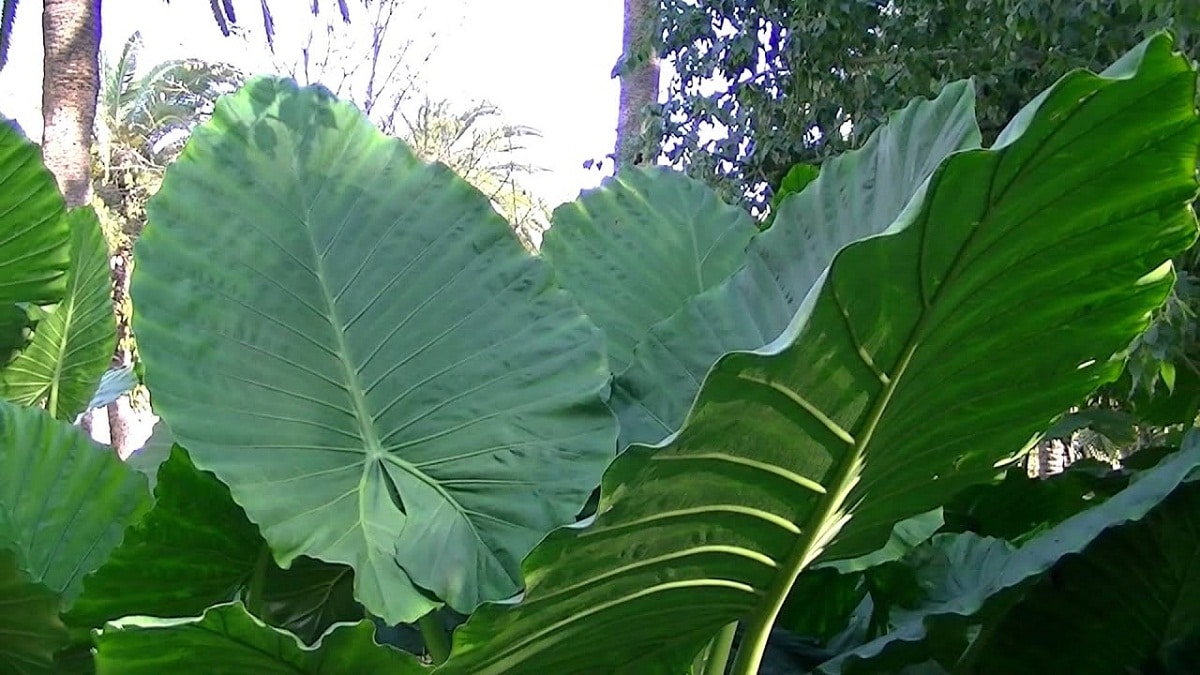
Today we will talk about a spectacular plant. Surely many of you have it decorating the living room of your home, or even in the garden. Something that is not surprising, since its leaves are very beautiful.
It belongs to the botanical genus Alocasia and there are different varieties. The most common is undoubtedly the Alocasia macrorrhizas, but there are others like Alocasia cucullata that also receive this name. The color it presents is soft green, due to chlorophyll.
Where is it originally from?
Its origin occurs in Asia, specifically in India and Sri Lanka. Later the primitive and domesticated cultivation of this plant spread to the Philippines and Oceania. Elephant ear grows in various currently tropical and subtropical regions, especially in the southeastern regions of China and Asia in general.
In the American continent, in Colombia, it grows in low areas of the Pacific and Atlantic coast, although it also develops in the inter-Andean valleys of the country and in the mountain range, where plants of other genera of the same family can grow.
Characteristics of the elephant ear plant
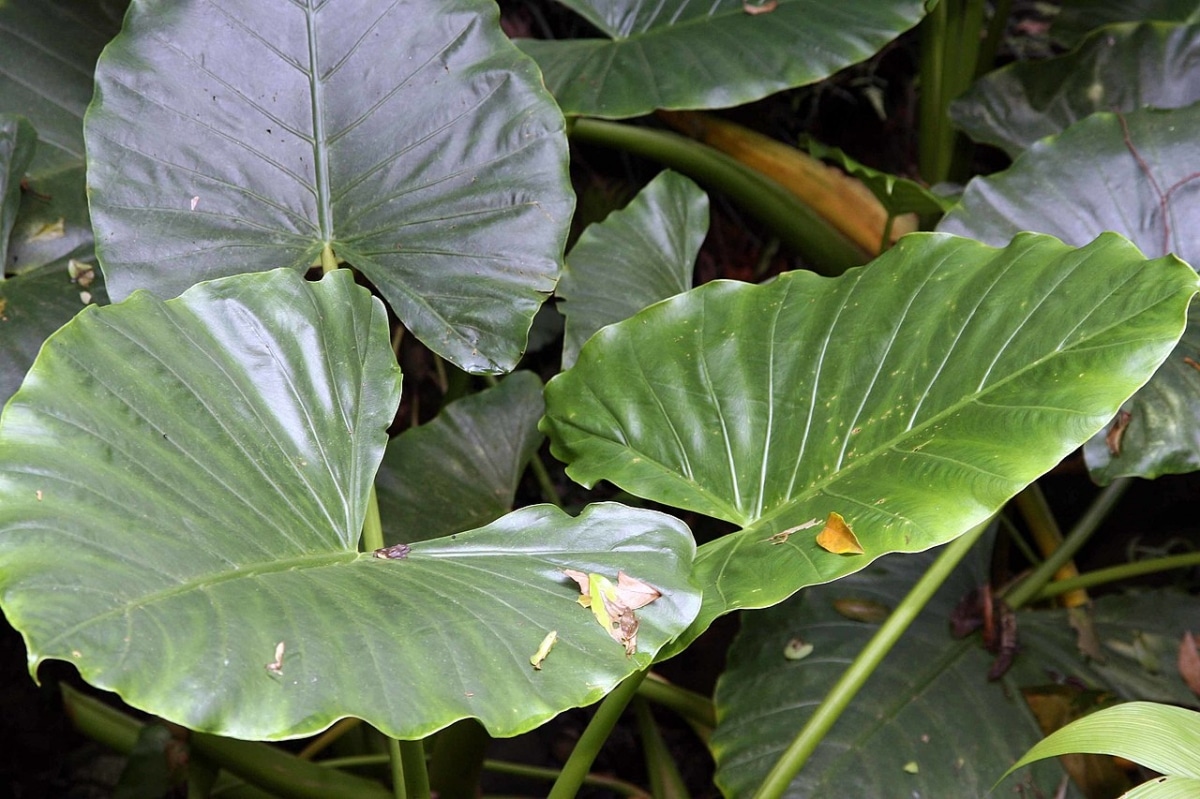
Image - Wikimedia / David J. Stang
Elephant ear is a plant that has large leaves, as mentioned above, which can measure up to a meter and a half in length, and that come from their base getting smaller until they reach the tip that is shaped like a triangle.
Mostly these they are usually green in different shades, although you can find some that have purple or bronze highlights.
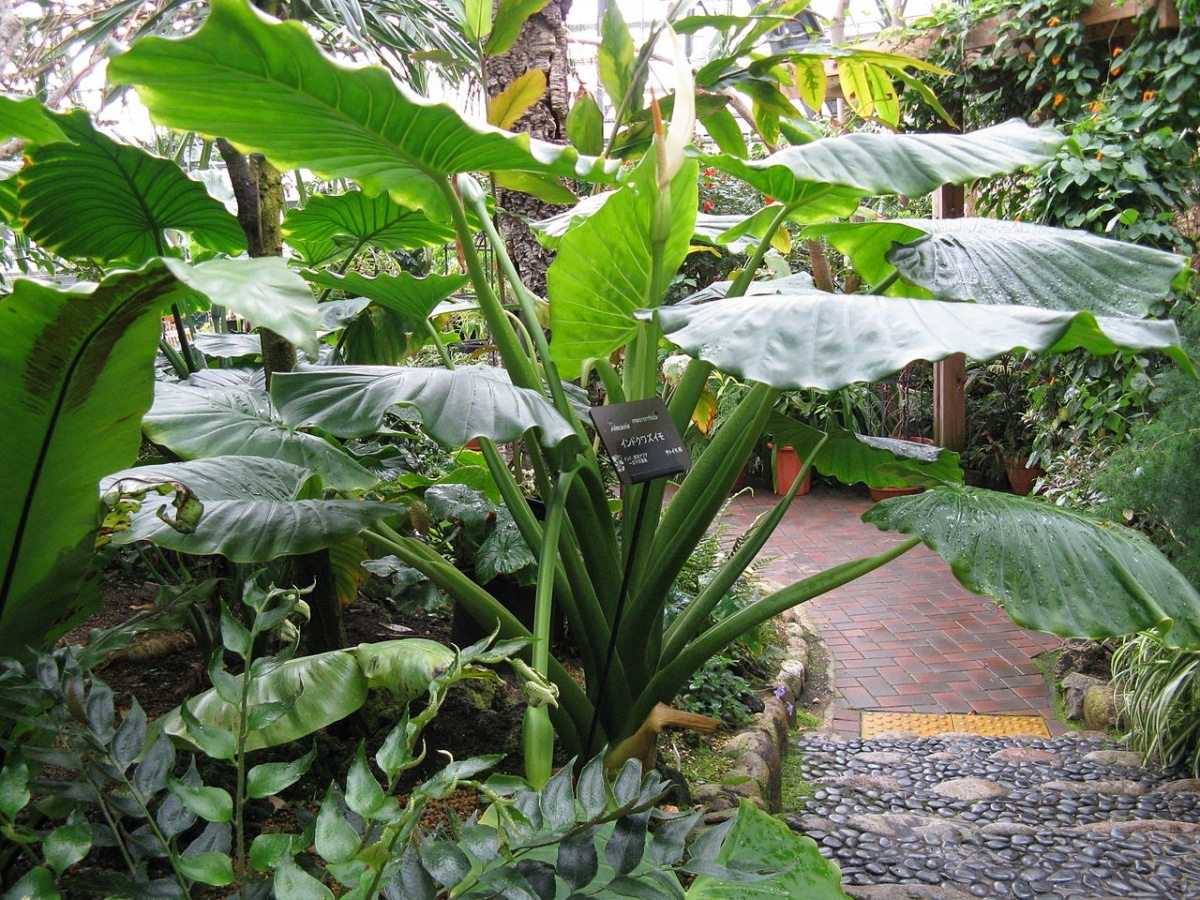
They have an elongated, underground and porous stem, and underneath you have their roots and above the buds, from which the leaves and flowers sprout. Nevertheless, on rare occasions this plant blooms, but when it does, this flower is called cane flower and has a whitish appearance.
This plant does not withstand freezing temperatures, so it is recommended to have it in a climate that does not have a very cold winter, unless the frosts are very short, or their leaves will be lost in that period of time. But don't worry, next spring they will sprout again.
The best for this type of plant is to thrive in hot climates, in a space in your garden that is slightly shaded. It is an ideal plant to have inside your house, in a room that has a lot of light and that is away from drafts.
For the elephant ear that is in a very dry environment, you will have to spray them on certain occasions, to avoid burning the tips. It is a plant that needs a lot of care, especially when it has been planted, but calm, then it will only need spraying.
It needs the sun to shine constantly during the day, so it will be better to place it in a strategic place for it.
Types or varieties of elephant ear
It is believed that there are about 50 different species of alocasias, but these are the most cultivated:
Alocasia amazonica
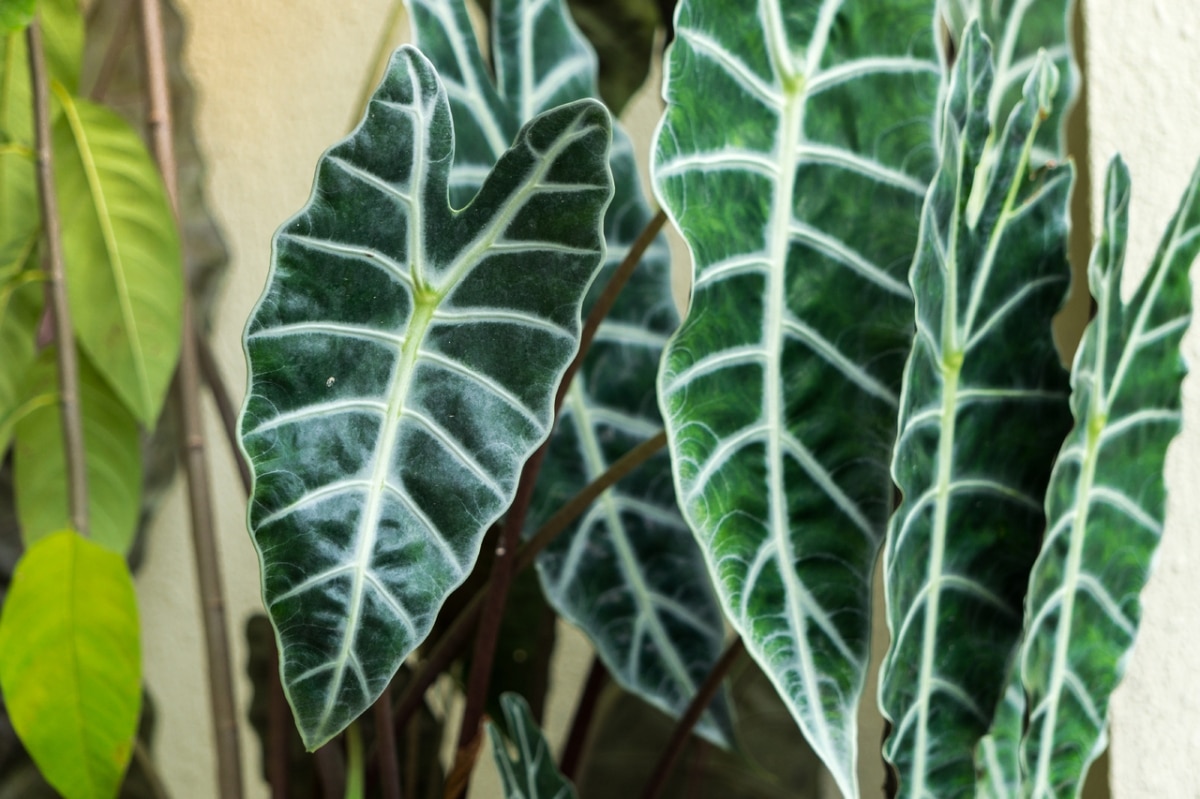
La Alocasia amazonica is a plant that does not exceed half a meter in height. It has leaves with a more or less triangular shape, dark green in color, and practically white nerves. This contrast is so beautiful that it is one of the most popular at home.
Alocasia cucullata
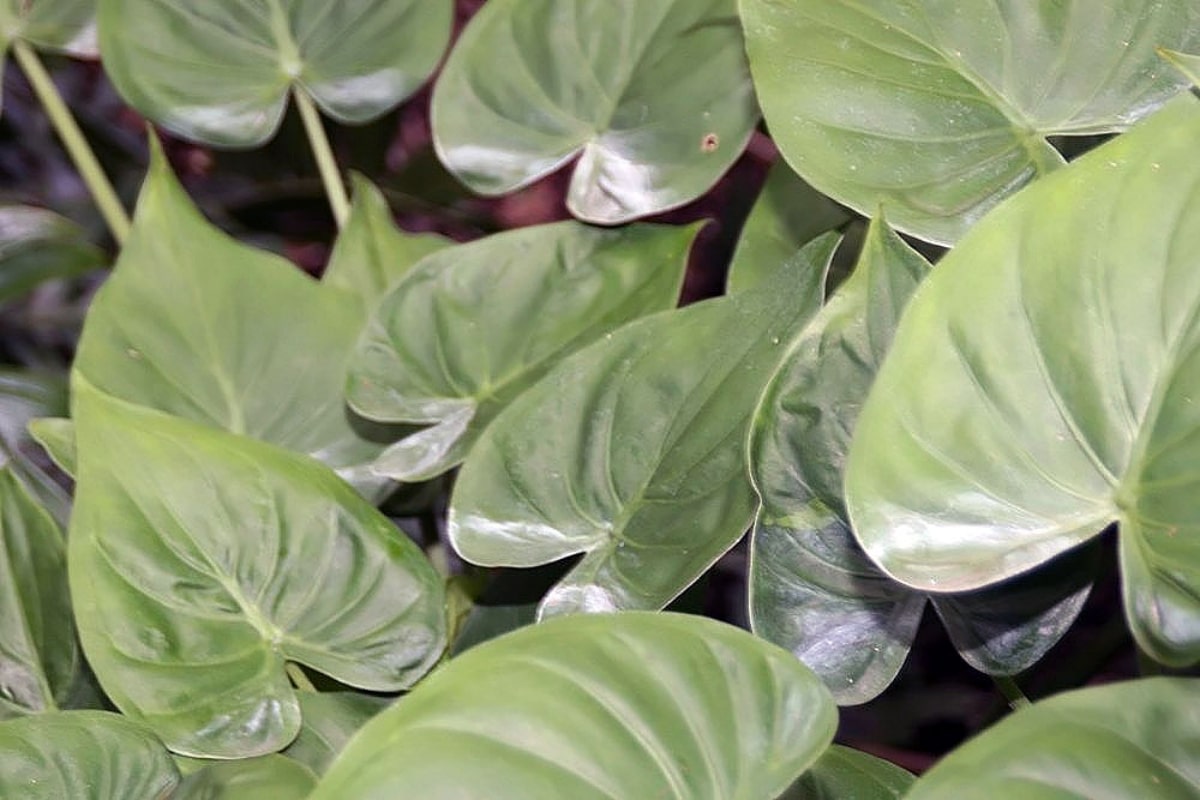
Image - Wikimedia / David J. Stang
La Alocasia cucullata It is quite similar to the one we are going to see below, but it is much smaller. It reaches a height of about 80 centimeters maximum, although the normal thing is that it stays at about 30cm. The leaves are green and heart-shaped.
Alocasia macrorrhiza
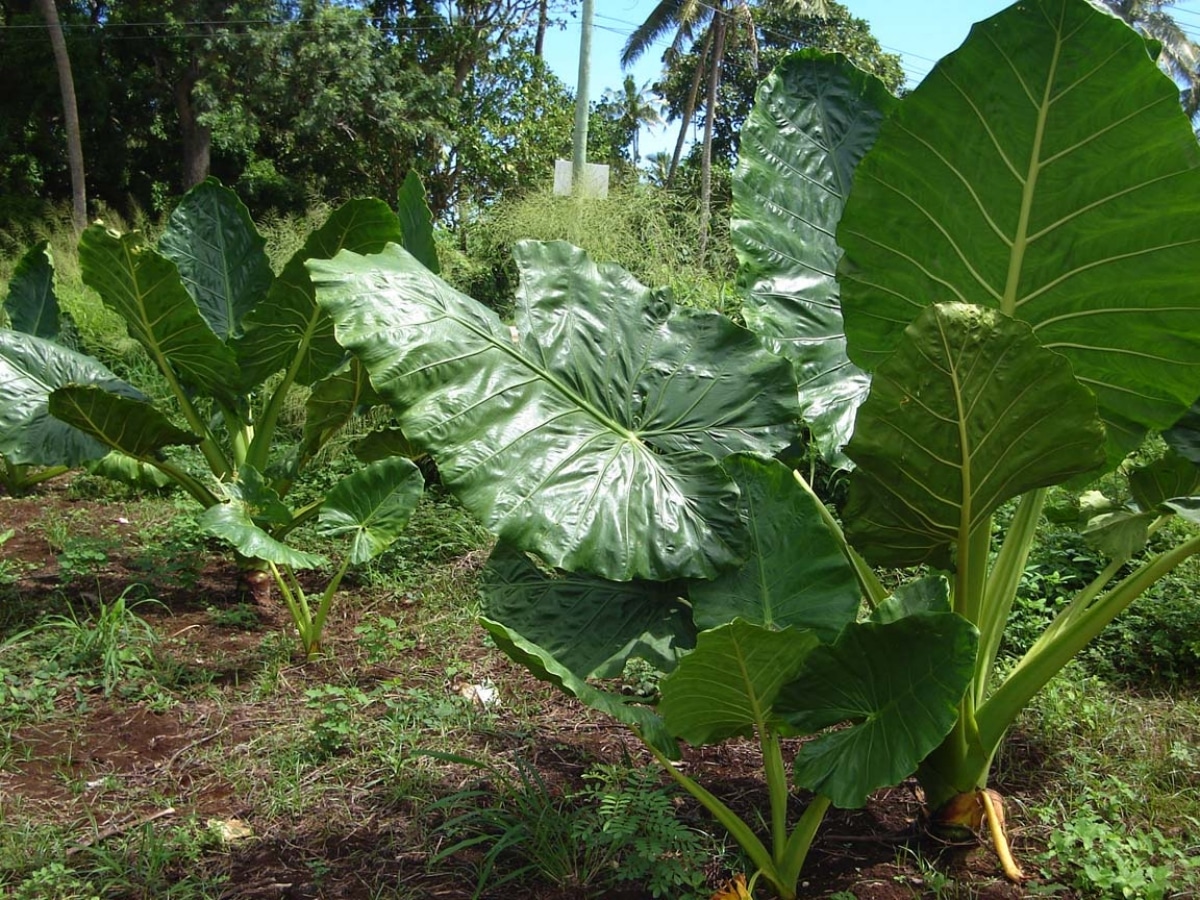
Image - Wikimedia / Tauʻolunga
La Alocasia macrorrhiza It is the quintessential elephant ear. Reaches a height of 1,5 meters, and also has quite large leaves, up to 50 centimeters long. These are a very pretty bright green colour, which looks spectacular both indoors and outdoors (if the weather is warm).
alocasia odora
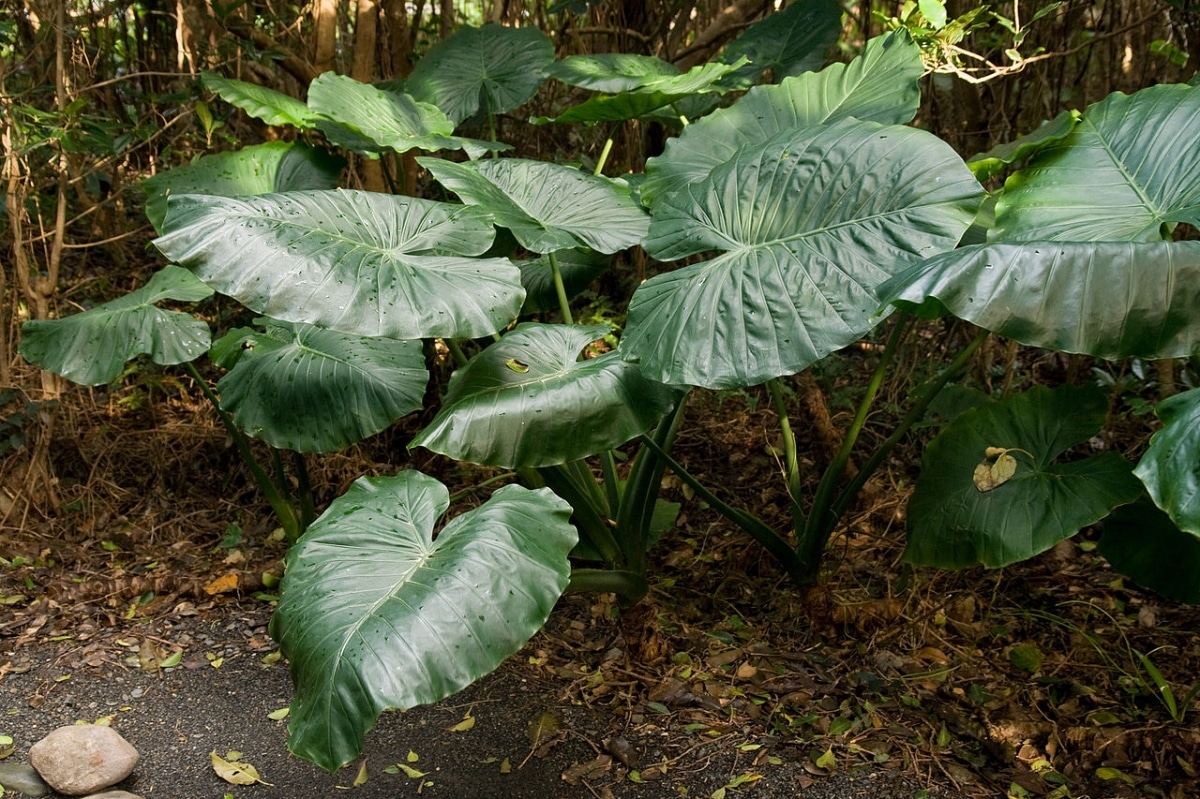
Image - Wikimedia / Σ64
La alocasia odora it is a plant known as giant upright elephant ear or Asian taro. Reaches a height of about 1 meter, and has simple leaves which measure about 40 centimeters in length.
Alocasia wentii
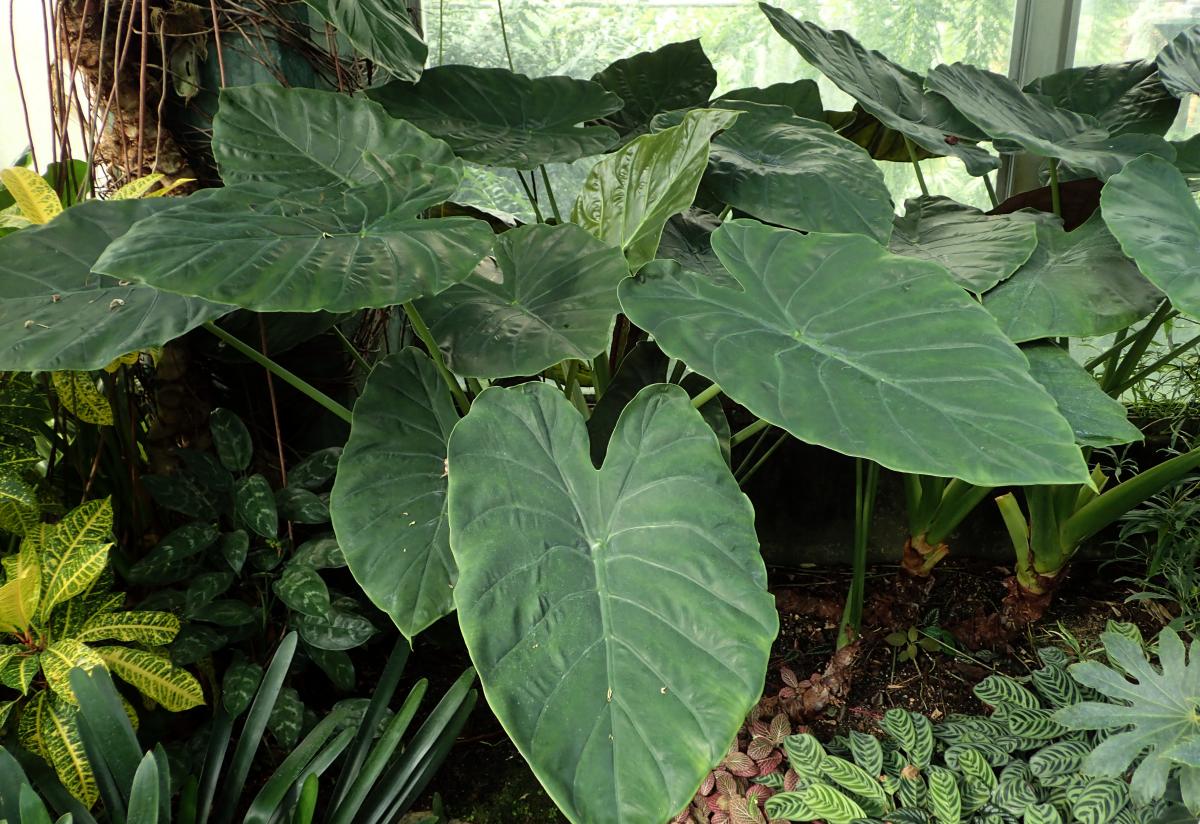
Image - Wikimedia / Krzysztof Ziarnek, Kenraiz
La Alocasia wentii is a species that can reach 2 meters in height, and develop leaves up to 60cn in length. These have a green face and a reddish underside, making it one of the largest species of the genus.
alocasia zebrina
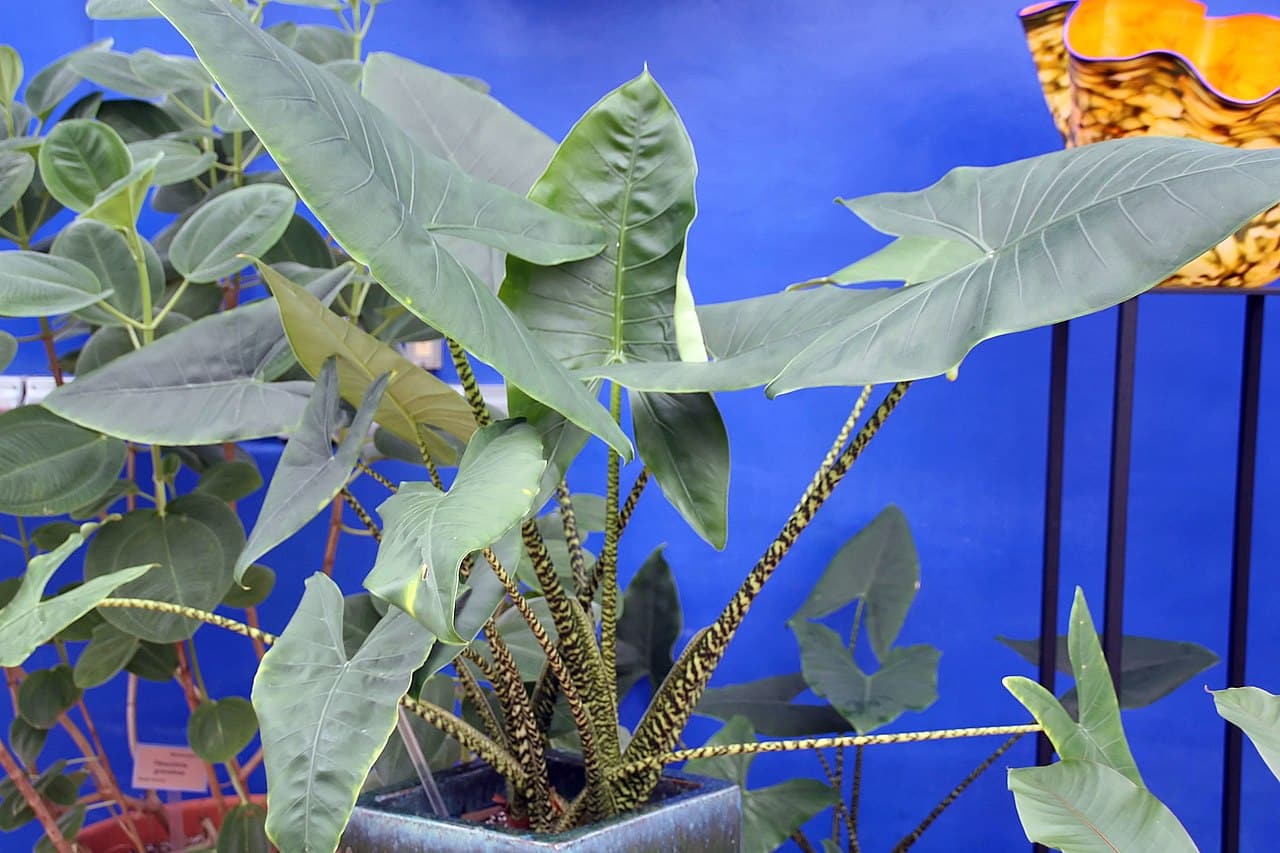
Image - Wikimedia / David J. Stang
La alocasia zebrina It is a plant with green leaves and very light yellowish stems with many dark spots, which is why it is also known as the zebra plant. It can reach a height of 1,8 meters, and its leaves measure approximately 1 meter.
Cultivation of the marquise plant

If you are one of those who has decided to plant an elephant ear at home, you should take into consideration the following:
When to pay it?
Whether planted in a pot or in the ground, it is advisable to fertilize throughout the growing season (from spring to late summer or early fall, depending on the weather) with an organic fertilizer, or with a liquid fertilizer for green plants such as Flower that you can buy here every fifteen days.
When do you have to water it?
And as for irrigation, this will have to be frequent, but the surface of the substrate must always be allowed to dry so that the bulb does not rot. It is a plant that will require, as we have mentioned, that after planting you water it constantly initially, but then with a few sprays it will be fine.
Plagues and diseases
Elephant ear is one of the plants that is rarely affected by some kind of pest or disease.
However, you may drop a mealybug, a parasite that feeds on the sap, causing the plant to present unusual stains, which must be removed with a cotton swab moistened with alcohol or you can also wash it with soap and water. Another option is to treat it with diatomaceous earth, which is a highly effective natural insecticide that you can buy from here.
If you have one of these in your house, you have to be careful when you cut itSince the sap released from its stem causes irritation to the skin and eyes, so be careful not to come into direct contact with it.
In the same way, you must be aware of the appearance of your plant, since this always has to be with its characteristic green color, but if its leaves turn yellow, this is because something is wrong with it, so it may be the humidity that is affecting it or that it is not being sprayed correctly on its roots and leaves.
Pruning
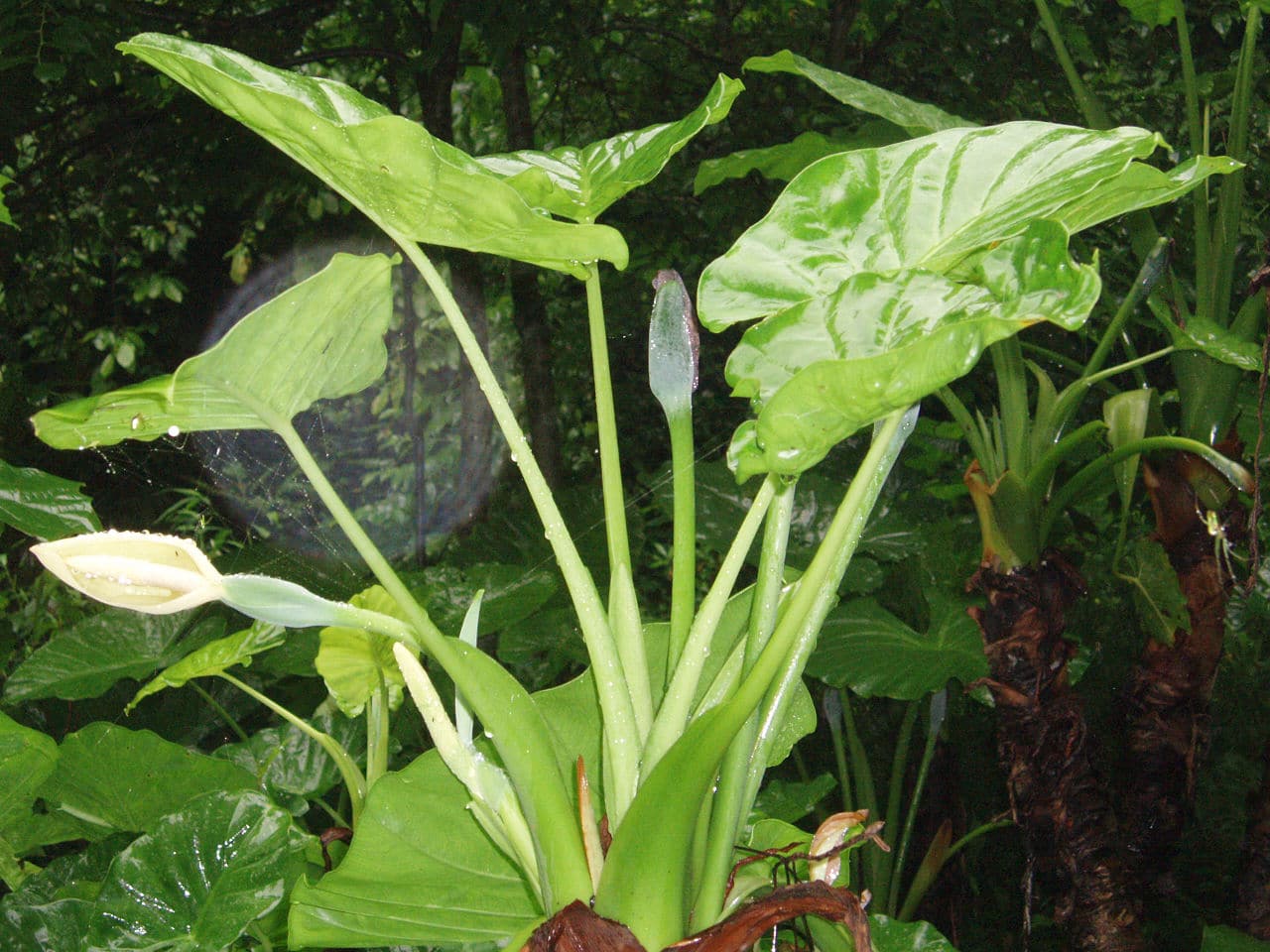
Image - Wikimedia / Fanghong
The plant doesn't require you to prune it like other plants do. However, in the event that some of the leaves turn yellowish, you will need to remove the leaves from the plant to prevent it from turning into a parasitic disease vehicle.
Used to cut the spoiled leaves, utensils that are clean and disinfected when you are going to do an operation on the plant, since you have to avoid that you can transmit a parasitic disease through these to your elephant ear.
How does the elephant ear multiply?
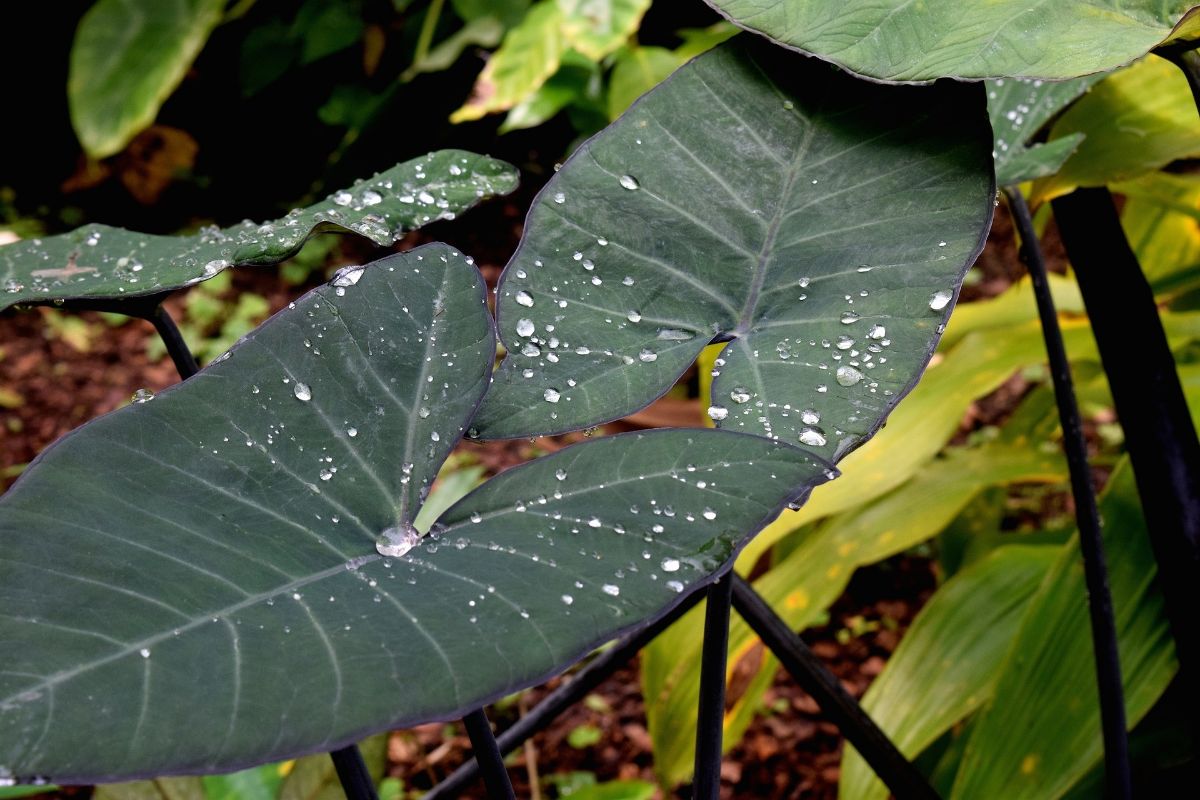
The multiplication of this plant is done by dividing the rhizomes, which should be done at the beginning of spring, dividing into proportions or detaching the rhizomes from the main bud, which in turn should have at least one bud or better two.
The cut surface of the rhizome has to be treated with a fungicide based on sulfur, in its powder form and you will have to let it dry for a couple of days, and then be able to bury it in a small pot with compost and soil, at a depth between 2 and 3 centimeters.
Now you will have to place the pot where there is a temperature that can be constant and around 24ºC, plus it must have shade. The substrate of your new plant must be humid until the fourth leaf comes out of it and then you can transfer it to a larger pot with this same substrate.
Is the elephant ear plant poisonous?
This is a plant that is considered toxic, since it has calcium oxalate, which can irritate people. However, in some cultures they use their leaves as the most tender vegetables and have different methods to cook them. Also, sometimes It is used to feed fish as a substitute for concentrated feed that is provided to them, allowing their owners to spread their food.
Pigs are also fed this plant in some regions, where farm producers use from the stem of the plant to the leaves, since these can replace in more than half the concentrate in the diet that they need.
Does the black elephant ear plant exist?
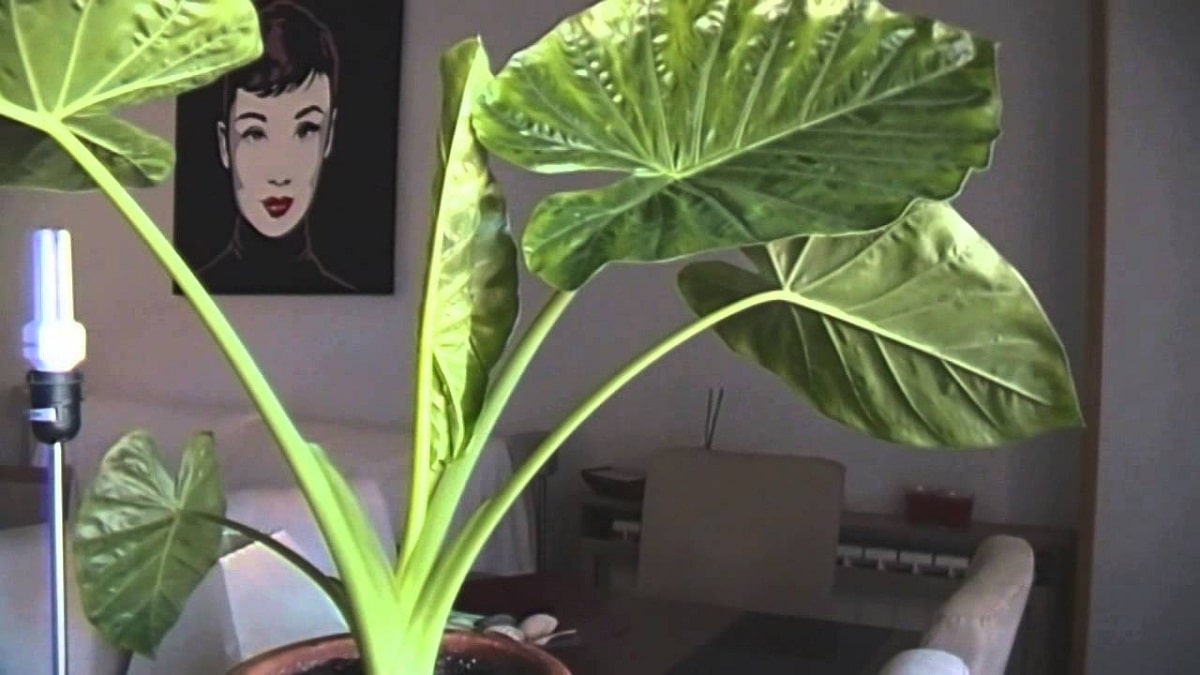
There is a black elephant ear, which has a similar appearance to those already mentioned in terms of its leaves, but that It has features that set it apart quite a bit. Its scientific name is Colocasia 'Black Magic'.
The leaves, in addition to their characteristic color, they have a velvety texture that does not have the "original". The truth is that the tonality that we can assimilate as black is actually a very dark green.
The size of this plant is between medium and small, so you will not need much space to have it, in addition to its slow growth, you will not have to move it for a long time.
The most important thing to note is that this is edible, specifically, its rhizome, which is cooked like any tuber. As for the flower that this plant has, it is really insignificant, but its interior is very similar to calla lilies due to its inverted cone shape.
It needs a special substrate so that it can maintain its green almost black color. This plant if it needs a good watering, that the "original does not need", Which implies that you have to have a pot with a good drainage system and more dedicated care with it.
In short, the elephant ear is a perfect plant for you to have inside your house, plus it doesn't require much careIt has a very ornamental appearance that can look good with the decoration you have on it, so you can dare to have it without any problem.




Can I keep the elephant ear all year long ?.
I live in a place where the temperatures are very low, can they grow without having to remove the bulbs by placing it indoors in winter and outside in summer? Or inevitably in winter the plant dies and I have to remove the bulb
Hello Begoña.
The elephant ear does not withstand temperatures below 0ºC, so it is advisable to keep it indoors at least during winter.
A greeting.
Hello Monica
Sorry maybe I have not explained myself well.
I have two large pots in which I have planted the elephant ears, but they tell me that in winter they die and I have to remove the bulbs from the pot and save them for next spring.
My question is if I keep them in good temperature all year round, they can continue to grow without having to remove the bulbs as if it were a perennial plant, it is a beautiful plant that can decorate my house and what I do not want is to start the plant year after year
Thank you
Hello again Begoña 🙂
You do not have to worry: if the temperature stays above 0ºC it does not die. The only thing that can happen is that the leaves are damaged a little if it is a little cold, but nothing more. Indoors they are kept beautiful all year round.
A greeting.
Thank you so much Monica !! It is a plant that I love for its spectacular beauty
Excellent publication, my Alocasia is several years old and I live in the Argentine province of Entre Rios, with a temperate climate; There are years with many frosts and it is outside because it came very giant, so the frosts burn its leaves and the petioles remain with the burned leaf. This year I cut them because by not having leaves I assumed that I was losing energy maintaining those fleshy giant petioles, and I added compost and a little foliage fertilizer and water it daily because we are having a significant drought.
And it was a beautiful surprise to discover that it had buds around the stem with leaves and in the middle a flower is coming out.
Since it came out alone for me, I want to know:
If it fertilizes itself and then I can harvest its seeds and how?
and if I dig around carefully I can harvest some portions of rhizome with bud and how do I do?
Because I am afraid of hurting it, it already measures more than 3 meters and has a main stem of about 20 centimeters, and I made it a special pot with a structure to combine it with other plants and be able to protect it from the cold and excess sun.
Hello Griselda.
The plant, as you say, is rhizomatous. The new stems that have come out - by the way, congratulations 🙂 - come from the rhizome.
The inflorescences have female and male flowers on the same plant, but in cultivation it is difficult to see it (although if yours is already a few years old it may be). But despite this, they do not pollinate themselves, since the female flowers appear first, and later, when they wither, the male ones appear.
This requires having at least two plants so that pollen passes from one to the other, and vice versa.
The fruits are easy to distinguish, since where before there were flowers, now there will be red 'balls'.
If you want to divide your plant, then you can do it in spring. To do this, you have to remove it from the pot and remove as much soil as you can. You may be able to easily separate the new sprout later.
Then, if you want to divide the rhizome, it is important that each piece has at least one bud, although it is better if there are two. The buds are like little bumps, as if they were a kind of "grains". You have to treat them with anti-fungal products, or with powdered copper, so that these microorganisms do not damage them.
Finally, they are planted in individual pots and watered.
Greetings.
I planted a potted elephant ear two days ago, but its fallen leaves are weakened ... will it be too much sun?
Hi Alejandra.
Could be. This plant does not want direct sun, but a shady corner without reaching total shade.
Greetings.
What happens if I cut this plant with my hand and I feel an unstoppable itch
Hello Angie.
Well, we already talked, but I comment on it here in case it happens to someone else.
Aloe vera is the best for itching, but if you don't have it, you can also use vinegar, leaving it to act for a few minutes on the affected area.
And if it does not improve, or if it worsens, go to the doctor.
A greeting.
Good Morning. In my house I have an elephant ear plant. But I cut a stem with bare hands. My hand itches. What I can do? Thanks
Hello Eugenia.
For itching, there is nothing like putting on a little Aloe Vera cream, but if it does not improve, it is better to go to the doctor.
A greeting.
Hello. The leaves of my alocasia have turned yellow and it looks very bad from the frost. What should I do so that I don't die? Cut the leaves? The stems are green
Hi Jonnhy,
Yes, you can cut the leaves and protect the plant with transparent plastic. In this way you will be better able to overcome winter.
A greeting.
Hello Monica! I bought one a few days ago and it is getting worse and worse !!! I took it out of the sun and now it has permanent shade, good temperature. Today liquid came out of the tip of one of the leaves. I was watering it a lot, since it had turned yellow, but now I read that I must be more careful and not water it so much.
Do you know why it loses liquid from the tips? What should I do?
Thank you
Hello Natali.
Most likely it is due to overwatering.
Before watering it is important to check the humidity of the substrate. To do this, you can insert a thin wooden stick to the bottom and, if when you remove it, it comes out with a lot of adhering soil, it means that it is very humid and that, therefore, it is not necessary to water.
You can also treat it with a systemic fungicide to prevent fungal growth. You will find this product in nurseries and garden stores.
A greeting.
Thank you very much!!!!!
In my pot, I found tiny white bugs on the ground that go in and out of the ground. I looked at them with a magnifying glass and they look like lice, they are white and have little legs. My plant has absolutely nothing neither in the stem nor in the leaves they are only on the ground. What is convenient to do?
Hello Maria Isabel.
The bugs you comment usually appear when the substrate is very wet. They do not usually harm plants, but if you want you can treat them with Cypermethrin 10%.
A greeting.
Hi Monica, good afternoon. My elephant ear, which I have in a pot, has been filled with tiny mosquitoes like ants; however the.plant is stupendous. What can I do to make them disappear? I thought it could be the humidity so I stopped watering it; but it is still the same. Thank you.
Hi John.
To eliminate these bugs you can treat the substrate with a universal insecticide for plants.
A greeting.
Hello. Moni, hear my elephant ear whenever a new leaf comes out, the oldest one dies, is that normal? But another one does not stop growing, it is like cyclical, I have it in a pot with a lot of humidity and heat since I am in Yucatan. Mexico
Hi Ivonne.
No, this should not happen. I recommend watering it less often, as it is likely to have excess moisture.
A greeting.
hello monica my ear also loses leaves and the old ones that are old are getting withered and like texturing. what could it be due to?
Hi Matias.
How often do you water it? From what you count, it looks like he's going thirsty.
It is highly recommended to check the humidity of the soil before watering, and above all to make sure that when it is watered it remains very humid. If the water comes out as it is poured, it is because it goes sideways. Then the plant is left without watering.
When that happens, you have to take the pot and put it in a bucket with water until the soil is well soaked. And from then on, watering 2 or 3 times a week.
A greeting.
Good morning
My leaves are turning completely white in the center of the leaf until they are withered and I am cutting them because it is seen that they are completely dead.
Any clue as to the possible motive?
First thing in the morning the sun gives them a little (when there is, which happens rarely in the North) and it seems possible that those leaves that receive sun are the ones that first begin to turn white.
I have started to put a little vinegar in the irrigation water thinking that it may need a more acidic PH. To know if it is correct.
For the rest, the plant develops very well, it has about 8 large leaves from the upper part of the trunk, as well as lateral "branches" that also develop leaves, having a total of about 20 leaves in a single plant of 1 mts. About.
I would appreciate any hints.
regards
Hello IAS, good morning.
White spots in a specific area of the leaves are usually sunburn. Although the sun in your area is not very strong or / or frequent, if the plant is near a window it is easy to "burn".
Anyway, if you want to upload an image to tinypic, upload photos or to another image hosting website, copy the link here and I'll tell you. You can also write to our profile Facebook.
A greeting.
Thank you very much for your interest, Monica.
Let's see if I do the tinypic right, which is the first time I try.
http://es.tinypic.com/r/xej1vo/9
Hello IAS.
Well yes, it looks like a burn. If you can put it in a place a little away from the window. But anyway, otherwise it looks pretty good.
A greeting.
Hello, good afternoon, my plant already has a stem of 80cm, and it has two small leaves, I have it in a pot in the open air, it gets the sun in the mornings from 9:00 to 2:00. A person told me that you have to cut it now, that it is very big. Besides, another plant is coming, I want to know if this is true?
Hi Norma.
You can prune it if you want, but I would recommend changing it to a larger pot (about 3-4cm wider) if you have not transplanted it in a long time.
A greeting.
Hello. The elephant ear plant is the same as the one known as taro. Which is edible?
Hi Bruno.
They look a lot alike, but no. The Elegant Ear is an Alocasia, specifically the Alocasia macorrhiza; instead the Taro plant is a colocasia esculenta.
A greeting.
Hi Monica, I hope you can help me. I just bought an elephant ear with 3 leaves but today one of them has bent at the stem and I don't understand why? Will it be necessary to put some reinforcement to the stem? I have tied them with a ribbon to help a little to the one who has "fainted" but I am worried because I do not know what care is necessary, perhaps I compost? Any vitamins? Can you please help me? Thanks a lot!
Hi Pamela.
Do you have it in a bright room? In order for it to grow well, it must be in an area where a lot of natural light enters, since otherwise what you say happens, that the leaves "fall".
Composting is only recommended during the warm months. In autumn-winter it can be paid (with a universal fertilizer), but reducing the recommended dose by half.
Water once or twice a week in winter, and 2-3 / week the rest of the year.
If you see that it gets worse, write us again 🙂
A greeting.
Hello, I have an ear in my living room, at first it had large leaves but since I have small children, they mistreated the little plant by cutting the leaves, now there are few leaves and very small ones, like the size of the hand. I want to regain its size I compost it but they are still as small as I can do
Hi miguel.
You can fertilize it with fertilizers rich in nitrogen, which is the nutrient that plants need to grow from spring to late summer.
Little by little it will take leaves of the size that it had before.
A greeting.
Hello, please help me. I have a pot with an elephant ear plant in my living room. They told me to water it once a week and that is what I have been doing but on the ground they are growing like mushrooms and this has been happening for a few weeks now and more and more are coming out, what can I do. Thanks
Hello Gaby.
I recommend you sprinkle the earth with copper or sulfur, this way you will eliminate the fungi.
A greeting.
Hello
They gave me 2 elephant ear plants and I transplanted them to my plastic pots, I have them outside where the light from the sil is filtered by my tree, I think it has enough light, the small plant has a yellow leaf stepped on and the plant large has 1 leaf with parts as burned, both plants only have 2 leaves and the stems look healthy, although I tie them to some iron bases to keep them upright since they were very fallen. What is causing them to turn yellow?
Thank you
Hello Nancy.
Does the sun shine directly on you at some point? You should not give these plants, as their leaves are immediately burned.
It could also be that they had excess iron, because of the bases you put on it. But I think it is sunburn that your plants have.
A greeting.
I have a space 3.80 meters long and 1 meter wide, next to an area of my grill.
I am about to buy 3 small elephant ears for that area, and I have doubt if it is the most recommended
I really like how it looks now
I just don't want it to be overgrown
Can I somehow keep it at the height and size that I want ???
Hi Josefina.
No, I do not recommend it. It's too little room for three.
You could put one and plant flowers around it for example, or ferns if it doesn't get direct sunlight. It could also be nice 🙂
Regarding controlling your height, no, it is not possible.
A greeting.
Hello Monica, I have read that you can dig up the bulbs, because my eared plant has been planted in the same pot for many years and every year I cut the leaves when they freeze and in spring they come out again.
But this past year it came out on one side of the pot and although the pot is very big it looks ugly that the plant is on one side
My question is: am I still in time to dig up the bulbs?
Here in my land there are considerable frosts
Thank you very much
Hello Elena.
I recommend digging up the bulbs in late summer or late winter. This way you will have a greater chance of them taking root.
A greeting.
Hello Monica,
You see three months ago that I moved into my flat and I found on the terrace, of the previous tenant, an Elephant Ear in a very large pot. It had 4 large and 12 small leaves growing on the ground. Although some leaves already had dry tips. But I only have two left. And I don't dare to water it because the earth is always wet. The sun hits it at XNUMX noon… Do you think I can get it back? It must be outside because I can't fit inside 🙁
What do you advise me? Thanks a lot
Hello Ana.
If you are in Spain tell you that it is normal that now in winter it becomes ugly, and that it even loses its leaves.
But it is important that you avoid watering it more, since the humid earth can be very harmful for it being in the time that we are. For this reason, I recommend you remove the plate if you have it. Then, it will only be a matter of watering once every 20 days, when the soil is dry.
A greeting.
Hello, it would be so kind to guide me, I have 2 SUITCASES with elephant ears on the roof of my house, the sun was not directly on it, now that I change places and in the afternoons the sun is shining I see in less than a week that they set 10 yellow leaves scared me and made me sad what can I do to save it, thanks for your advice ... ahhh and how many times a week I water them
Hi carmen.
The sun coming through the window is probably burning them. I recommend you move them away from the window and water 2-3 times a week avoiding waterlogging.
A greeting.
Hello, look, I have some plants but the frost passed and I burn them, I cut the leaves but now the leaves come out Chinese and they also have snails I don't know what to do I hope it helps me
Hello jhon.
If you have snails, here you have tips to combat them.
A greeting.
Good afternoon!
Question: The stems of my Elephant Ears plants are currently very large.
the problem is that the pots where I have them, no longer support their weight.
how can i control this?
One person told me that I could trim the stem and re-plant it.
Is this true?
Hi carlos.
Yes, you can trim the stem in spring, but if it is so big, you can plant them in larger pots or in the ground.
A greeting.
Hello, a few months ago, I bought an elephant leaf plant, it had 3 leaves and now it has 5 but there is always one of the old ones that turns yellow and dies, the man where I bought it told me that there was no need to change the plant and I have not changed it, another thing because of the comments I have seen about the irrigation I do it well but I have to put some pebbles on the plate where I have it so that it does not flood I beg you please tell me what I have to do THANK YOU VERY MUCH
Hello manuela.
It is normal for older leaves to turn yellow and ugly as they have a limited life expectancy 🙂
Anyway, I would recommend you move it to a larger pot in spring, and put stones in the plate.
A greeting.
Hello Monica, I have a question to my elephant ear, new leaves not so large came out from the trunk and I just removed them, can they grow roots to transplant them into a pot? Or do they no longer have salvation? 🙁
Hello Gabriela.
No, this plant cannot be multiplied by leaf cuttings.
But do not worry, that will surely come out of new ones.
A greeting.
Hello, I want to know why my elephant ear when I release a new leaf, an old one dies ... is it common in the plant? because she doesn't have many and she's old
Hola!
If it has been in the same pot for a long time (years), I recommend transferring it to a larger one so that it can continue to grow.
You can also pay it once a month or every 15 days with a compost for green plants.
Greetings.
hello, my elephant ear has a very long stem (between 1m and 1,3m) with many leaves, can you cut that stem? Will more leaves grow in the cut part?
Thank you
Hello Francisco.
No, if you cut the stems, they will not come out again.
Being a herbaceous plant it does not sprout from the stems.
Greetings.
Hello, I have been looking at it and on the back of the sheet there are usually some very small white bugs that seem to be dissected with 2 antennas and several legs around them.
I like to know what they are and why they come out.
Thank you.
Hello Aaron.
See if they are mealybugs. They appear when the environment is warm, especially during spring and summer, but especially when the plant shows some sign of weakness.
You can remove them with a swab from the ears soaked in pharmacy alcohol.
Regards!
Hello
My elephant ear was super pretty but the leaves below were bending the stems and turning yellow and I have seen that they say that we cut the leaves but what I understand is: it is cut from the stem or only the leaf and of those that are bent short from where it bent?
I think what happened is due to excessive watering 🙁 because healthy leaves come out like water hahaha
I hope you can help me 🙂
Hello Maria.
We only recommend cutting what is wrong, that is, the yellow part. The part that is green is still used by the plant to photosynthesize and grow 🙂 Although anyway you have to know that when the leaf dies, the stem does not take long to dry.
If it's bent but still green, don't cut it. But if on the contrary it is yellow, then yes.
Yes, it is possible that it was overwatered. Do you have a plate under the pot? If so, I advise you to remove the excess water after each irrigation. And space those risks more, too.
Greetings.
Hello!!! I have an elephant ear plant that my sister brought me in a bottle with water, its roots were growing, the leaves were never very upright, but two new leaves grew, I passed it to a pot, it is still inside my house in front of a window that gives sun during the day but I am seeing that its leaves began to roll up.
For what reason can it be?
Hi Ivon.
Does the sun shine directly on you, or through a window? If so, I recommend moving it away a bit, since it is surely burning.
If it still does not improve, or if you have doubts, write us again.
Greetings.
Why do the leaves turn golden and dry?
Hello Ana.
If the sun is shining on it or it is by a window, it is because it is burning.
It may also be because when watering the leaves get wet (it is better not to do so).
Another possible cause is that the soil is always wet. Although it is a plant that must be watered often, it is important that if it is kept in a pot it has holes so that the water can escape.
Greetings.
Hello! I am Gustavo. Very good information on this beautiful plant however I have a question. What do you mean when you say you have to spray the plant? Thanks
Hello Gustavo.
Spraying is spraying, in this case with water, with a spray bottle 🙂
Regards!